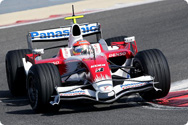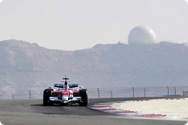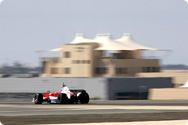|
|
Traction in Action:Life without Traction Control
31.03.2008
Supreme driving skill is a prerequisite for any Formula 1 driver but the class of 2008 are getting the chance to show their car control skills even more than in previous years thanks to the elimination of traction control.
Purists have long argued that traction control - an electronic system which regulates power to the rear wheels to eliminate wheel-spin - spoils the spectacle of Formula 1. But the 'good old days’ of iconic drivers demonstrating their mastery over their machine by taking it to the limit of traction and beyond are back.
The introduction of a standard electronic control unit (ECU) has seen the elimination of traction control for 2008, and the first two Grands Prix of the year have already proved spectacular - with more dramatic moments sure to come in this weekend’s Bahrain Grand Prix.

For Panasonic Toyota Racing, the absence of traction control gives Jarno Trulli and Timo Glock the perfect opportunity to show off their awesome combination of car control and raw speed.
Jarno has spent most of his Formula 1 career driving with traction control but he is famed as a true artist behind the wheel and the current regulations give him more freedom to express his passion for the perfect lap time. “The traction control ban is a good thing because technology had taken over driver input,” he says. “It is good to have a step back and give the car back to the driver. It is more fun and we have more input into car performance. I like it because you need to be more sensitive and you really need to drive the car.”
For Timo, life without traction control is the norm after spells in Champ Car and GP2 gave him experience of handling powerful single–seaters without the comfort zone of electronic aids. However, he says: “In the end we are supposed to be the 22 best drivers in the world and I think everyone is good enough to adapt quickly to driving without traction control.”

“With traction control you can go more to the limit; it’s the right way to go, to bring a bit more control to the driver and that makes it interesting. It’s good for the fans to see more black marks on the track again!”
Team manager Richard Cregan also has no doubt that putting more emphasis on driver skill, and providing a more impressive spectacle in the process, is a winning combination. “It’s certainly given us more exciting racing and I think anything that puts the control of the car back into the hands of the driver has to be positive in terms of the spectator,” he says. “We've seen that already and I think it’s a very positive thing.
“Trying to control that much horsepower in a car which is quite delicate puts a lot more back into the hands of the drivers. But these are professionals and they go out there with a passion to win; they have to show what they can do without traction control. There's been a lot of discussion about it – but my personal view is, get out there, drive the car, show what you can do – it’s about your talent as a driver.”
The lack of traction control impacts not only the driver. The Panasonic Toyota Racing engineers have had to adapt the set-up of the TF108 to suit the slightly different requirements a driver has when he can no longer rely on electronics to keep the rear wheels in check, with slightly more downforce required for optimum set-up this year. Jarno’s race engineer Gianluca Pisanello explains: “The ban on so-called driver aids has changed the approach of the teams and the drivers in certain areas of development, setup and driving. The development of the car has to, of course, cope with this new challenge; you want a car which is well balanced on corner exit when you go on throttle, so that the traction is still there even without traction control.”

“We need to be very careful with the handling characteristic of the car particularly in Bahrain with a sandy circuit,” says Head of Aerodynamics Mark Gillan. “Overnight the wind can blow in sand, so usually the track starts off green but it then gets 'rubbered in’ through the through the weekend. However, with Bahrain you can get sand blowing over the rubber as well.
“With the loss of traction control then obviously the cars are more prone to wheel-spin and we need to be sure that we provide a more stable aerodynamic car just to counter any instability which may come without the traction control.”
movies |
||||
|
